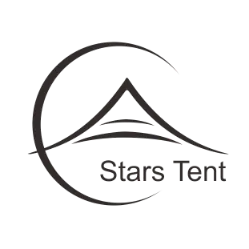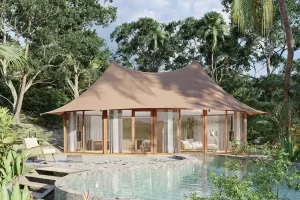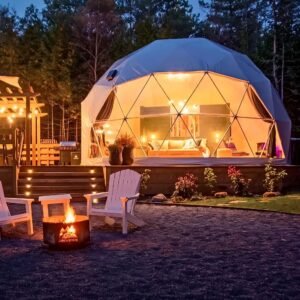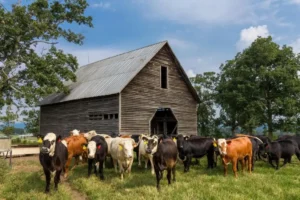Understanding Geodesic Dome Tents
Have you ever envisioned a distinctive, eco-friendly structure for your event, glamping experience, or creative workspace? Geodesic dome tents provide a versatile and sustainable solution that captivates attention.
What is a Geodesic Dome Tent?
A geodesic dome tent is a spherical structure composed of interlocking polygons, usually triangles or hexagons. These tents are ideal for events, parties, and unique workspaces. Whether you need an elegant wedding tent, a vibrant party venue, or a practical storage area, geodesic dome tents are an excellent choice.

Why Opt for a Geodesic Dome Tent?
Choosing a geodesic dome tent is a wise decision if you’re seeking a unique, sustainable structure. Our dome kits and custom designs offer flexibility to meet your budget and specific needs, whether you’re planning a greenhouse or a spectacular event space.
Advantages of Geodesic Dome Tents:
- Strength & Durability: Featuring reinforced galvanized steel tubes, our tents are built to endure extreme weather conditions, including snowstorms, heatwaves, and heavy rainfall. They even offer resilience against earthquakes, with a reliable shingling system that prevents leaks.
- Spacious Design: Ideal for corporate events, exhibitions, and high-end gatherings, our tents provide expansive interiors with ample space for creativity.
- Rapid Deployment: Our dome kits are easy to assemble and deploy, making them perfect for urgent needs, such as emergency shelters or last-minute events.
- Luxury Interiors: Our tents come with panoramic windows, customizable layouts, and a blend of elegance and practicality, providing a luxurious experience.
- Eco-Friendly: Designed with sustainability in mind, our geodesic dome tents minimize environmental impact while maximizing usable space.
Construction Time: How Long Does It Take?
The time to build a geodesic dome tent depends on its size and complexity. Smaller kits can be assembled in two to three days by DIY enthusiasts, while larger tents may take up to two weeks, accounting for customization and local regulations.
Essential Considerations for Building Your Geodesic Dome Tent
When planning your dome tent project, consider the following factors:
- Types of Geodesic Dome Tents: Choose from a range of sizes and materials to suit your needs, whether for a greenhouse, retreat, or large-scale event space.
- Diameter and Purpose: Domes range from under 10m for personal use to over 20m for major events. Choose a size that aligns with your intended use and budget.
- Materials and Tools: Our kits include high-quality materials such as PVC and polycarbonate panels, along with all necessary tools and guides.
- Permits and Regulations: Ensure compliance with local building codes and obtain all required permits to avoid delays.
Detailed Steps to Assemble Your Geodesic Dome Tent
Building a geodesic dome tent requires careful planning and execution. Follow these detailed steps to ensure a successful assembly.
1. Frame Construction:
Begin by assembling the frame of your geodesic dome tent. The frame consists of interconnected triangles that form a spherical structure. The frequency of the dome, which refers to the number of subdivisions of the base triangles, affects the dome’s strength and appearance. Higher frequency domes have more triangles and are closer to a perfect sphere, offering greater durability and aesthetic appeal.
- Assemble the Base: Start by laying out the base structure. For larger domes, this may involve securing the base to a foundation or ground anchors for stability.
- Connect Struts: Attach the struts according to the layout plan. Use connecting hubs provided in the kit to secure the struts at the correct angles, forming the triangular shapes.
- Build Upwards: Continue building upwards, layer by layer, connecting the struts to form the full dome shape. Ensure all connections are secure and aligned properly.
2. Connecting the Struts:
Securing the struts properly is crucial for the stability and durability of your geodesic dome tent.
- Bolts and Nuts: For larger or more permanent structures, use bolts and nuts. Ensure that all connections are tightened properly to maintain the structural integrity of the dome.
- Zip Ties: Suitable for smaller or temporary domes, zip ties offer a quick and easy way to secure the struts. While not as strong as bolts and nuts, zip ties provide sufficient stability for lightweight structures.
- Specialized Connectors: Use specialized connectors or hubs designed for geodesic domes to ensure precise angles and secure connections. These connectors are particularly useful for complex or high-frequency domes.
3. Door and Window Installations:
Adding doors and windows enhances the functionality and comfort of your geodesic dome tent.
- Planning and Marking: Determine the ideal locations for doors and windows, considering factors such as ventilation, natural light, and interior layout. Mark the positions clearly on both the interior and exterior of the dome.
- Creating Openings: Carefully cut openings in the dome’s covering material, following the dome’s curvature to ensure a snug fit. Use appropriate tools for cutting the material based on its type (e.g., PVC, canvas, polycarbonate).
- Installing Frames: Install frames for doors and windows if needed, ensuring they are securely attached to the dome structure. This step may involve using screws, bolts, or adhesives, depending on the material and design of the dome.
4. Covering Your Dome:
The choice of covering material and the method of attachment significantly impact the dome’s performance and aesthetics.
- Material Selection: Choose a covering material based on your needs:
- PVC: Durable and weather-resistant, PVC is ideal for permanent or semi-permanent structures.
- Canvas: Offers good insulation and breathability, suitable for climates with temperature variations.
- Tarpaulin: Lightweight and easy to handle, tarpaulin is ideal for temporary or seasonal domes.
- Polycarbonate Panels: Provide excellent durability and UV protection, ideal for long-term installations.
- Attachment Methods:
- Lacing: Use ropes or cords threaded through eyelets along the edges of the covering material. This method allows for adjustments and tightening as needed.
- Clips: Suitable for quick assembly and disassembly, clips securely fasten the covering to the frame.
- Straps and Buckles: Provide a secure and adjustable attachment, accommodating changes in tension due to weather conditions.
5. Final Inspection and Adjustments:
After assembly, conduct a thorough inspection of the geodesic dome tent. Check all connections, ensure the covering is secure and free of wrinkles or gaps, and make any necessary adjustments to doors and windows.
By following these detailed steps, you can build a sturdy, functional, and aesthetically pleasing geodesic dome tent that meets your specific needs.
Collaborate with Shelter Structures for Your Dome Tent Project
Ready to bring your dome tent vision to life? Shelter Structures offers customizable kits that allow you to create a space reflecting your unique style and needs. Whether hosting an event, building a greenhouse, or creating a cozy retreat, we provide the expertise and tools to make your project a success.
Discover more about our commitment to sustainable, modular living spaces and join us in creating innovative, eco-friendly structures.




